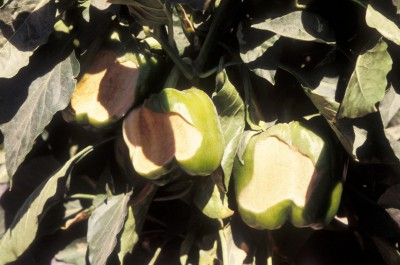Jan 13, 2017Mushy spots on peppers: Disease or disorder?
Frustration in pepper season can arrive when plants, healthy and strong in appearance, start to produce peppers with discolored, mushy spots. While the first instinct might be that there’s a pathogen out there infecting the peppers, it is important to understand that diseases are rarely the sole cause of fruit rot, and in reality it is more likely the pepper has been damaged by weather conditions interacting unfavorably with the pepper’s physiology.
Below are three of the biggest culprits for peppers affected with legions: sunscald, blossom end rot and anthracnose. With proper identification of the problem, you can decide if a spray is needed or if a re-evaluation of pepper planting and upkeep strategies for next year would better address the problems you are seeing.
Sunscald
The damage is initially tan, but the area can then be infected by fungus and bacteria, making differentiation between sunscald and other issues more difficult. This is a condition that occurs when the fruit on the plant are exposed to a combination of intense light and high temperatures. The high heat breaks down the pepper tissue while the sunlight causes adverse chemical reactions, which cause tan areas on exposed areas of the pepper fruit. This is most commonly seen in bell peppers, and selecting a variety with vigorous foliage in the next planting year can help shade fruit.
Blossom end rot
Despite the name, this disorder can cause confusion with sunscald as it can appear on the bottom (blossom-end) and side of pepper fruit. This disorder manifests itself as dark, circular lesions, and is generally attributed to calcium deficiency, but is more often caused by a mismatch between where calcium is available and where it is needed. If a fruit is growing or ripening in dry conditions, there may not be enough water present to get calcium to the developing fruit. Or, the water may be routed to the leaves where the water is needed, but not the calcium, which the developing fruit needs.


This disorder can be seen in bell peppers as well as banana peppers. Symptoms can be reduced with regular irrigation, but double-checking calcium levels in the next year’s soil tests may provide peace of mind.
Anthracnose
While this disease mainly impacts tomatoes and potatoes, it can occasionally show up on peppers, especially if the fruit has been left on the plant for extended periods of time. As the pathogen develops on the fruit, soft, sunken lesions will appear, which sometimes take on a black appearance. Concentric rings are a signature sign of fungal infection in plant tissues, and when coupled with a pustule of salmon-colored spores, there is a good chance your pepper plants are infected with anthracnose.


A variety of fungicides can be used to manage anthracnose. Michigan State University Extension suggests that treatment at the first appearance of the disease, as well as prompt harvesting, will keep anthracnose out of the field. Follow label instructions and pay attention to the post-harvest interval. Also, rotate out of solanaceous crops at least every two years.
— Marissa Schuh, Michigan State University
Source: Michigan State University















